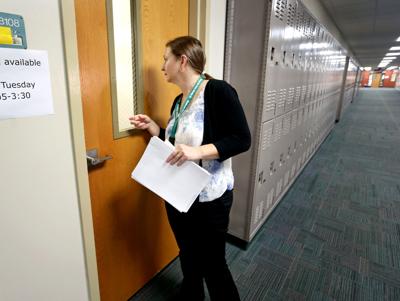South Carolina’s teacher shortage grew even deeper last year as new teachers quit the profession in greater numbers and more veteran educators retired.
Some 7,300 teachers left their jobs before the current school year started, accelerating an annual exodus from the state’s classrooms, according to a Winthrop University study released Monday.
The latest wave of departures was 10 percent larger than the year before, representing hundreds more teachers.
The overwhelming majority — more than 5,300 teachers in all — left South Carolina’s public schools altogether.
The survey results were announced at a moment when state lawmakers have already vowed to make fixing schools — and narrowing the teacher shortage — their top priority. Interest in an education overhaul has grown since The Post and Courier’s five-part “Minimally Adequate” series detailed broad disparities in the state’s education system that now threaten the state’s economic vitality.
South Carolina has been reckoning with a teacher shortage for years, and lawmakers feared it was reaching crisis levels even before the latest survey found the situation was growing more dire.
“It’s just more of the same,” said Jennifer Garrett, who wrote the study for Winthrop’s Center for Educator Recruitment, Retention and Advancement. “It’s a situation that is just compounding each year, and we’re in a place where it’s going to take some time to get out of it.”
But the study, which surveyed the state’s school districts, raised fresh alarm bells.
The number of new teachers is dwindling — fewer college students are enrolling in South Carolina’s education schools — and the state is struggling to keep new teachers on the job. That bleak math led to more than 600 vacant teaching positions when the school year started, growing by nearly a third in two years.
Consider that one in four new teachers left the classroom after just one year. Or that nearly half of all teachers who quit last year before hitting retirement age had been on the job for five years or less.
Saani Perry understands why they leave. He's a fourth-year teacher in the Fort Mill School District, and even in one of the state's best districts, he's gotten whiplash of a sort. His time is sliced up by meetings and paperwork, he says, rather than planning lessons. College prepared him to teach, but he wasn't ready for the workload.
"The workload and what we're being paid to do — they don't align," said Perry, who sits on the board of SC for Ed, an advocacy group that has called for a 20 percent teacher pay raise. "I expected to be able to do what's best for kids, and I don't feel that I have the opportunity to do that unless I do it at home."
The teacher shortage also deepened among veteran teachers, as nearly 2,000 retired last year, the Winthrop study found. The state ended a program last year that let retirement-age workers collect pension checks and paychecks, pushing thousands of employees off government payrolls.
“Regardless of how the data are examined, it can be concluded that too many early-career (and veteran) teachers leave the classroom each year,” the study found.
The "Minimally Adequate" series detailed how classroom pressures and pay concerns have fueled the crippling teacher shortage across the state. Teachers’ pay increases have not kept pace with inflation since the Great Recession, according to statistics compiled by the National Education Association. At the same time, classroom sizes have swelled.
State Education Superintendent Molly Spearman, a Republican, has suggested addressing the teacher shortage by giving teachers a 5 percent pay increase and reducing the burden of standardized testing on teachers. Several lawmakers have voiced support for boosting teacher pay, as well, but there is disagreement on how big a raise they should get.
The state’s struggles with education center on a path of historic inequities from Dillon to Allendale, and the teacher shortage is no different. The Pee Dee region in South Carolina’s northeast corner accounted for nearly a third of the state’s teacher vacancies, but only a sixth of its teachers.
Those schools often turn to stopgap measures like hiring foreign teachers on three-year visas. Close to 400 new teachers came from abroad this year, a rate that has quadrupled in the last five years. International teachers outnumber native-born educators at some schools in the Pee Dee, leaving school districts to constantly fill openings.
“It could be the highest-quality teacher you can find, but they leave. They have to go back to their home country,” Garrett said. “Regardless of the effectiveness of this teacher, it’s temporary. So after three years, the district’s right back in the same position.”







